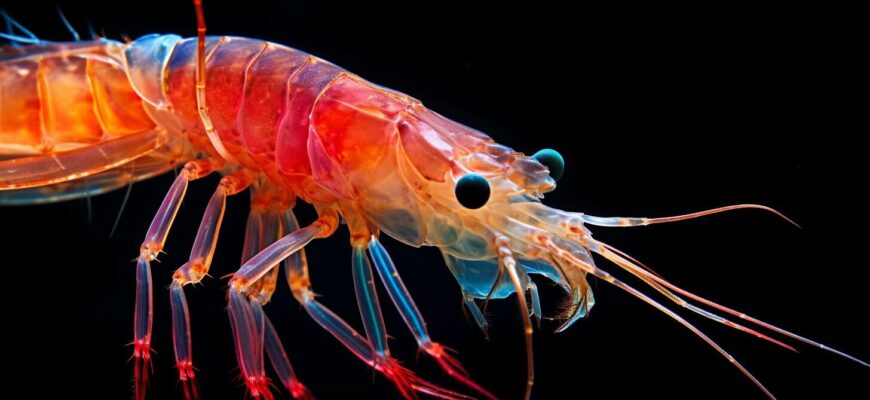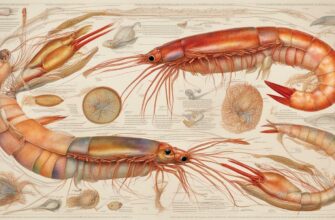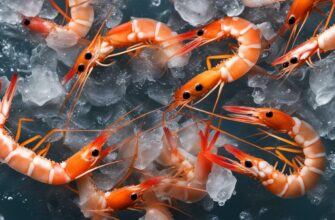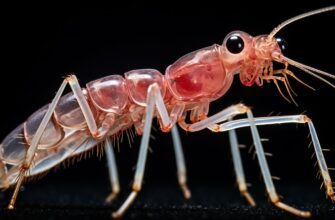Shrimp are fascinating creatures that have long intrigued scientists and casual observers alike. Despite their small size, these marine crustaceans possess a complex array of behaviors and sensory mechanisms that suggest some level of intelligence. But do shrimp actually have brains like other animals, or is their behavior simply a result of instinct and reflex?
As we delve into the world of shrimp intelligence, we will explore the anatomy of shrimp brains, their cognitive abilities, and the natural and captive behaviors that provide insight into their level of intelligence. So, let’s explore this enigmatic creature and finally uncover the truth about shrimp brains and their intelligence
- The Anatomy of Shrimp Brains
- The Structure of Shrimp Brains
- Do Shrimp Exhibit Intelligent Behavior?
- Shrimp Intelligence in the Wild
- Examples of Wild Shrimp Intelligence
- Shrimp Intelligence in Captivity
- Can Shrimp Learn and Remember?
- Can Shrimp Be Trained?
- What Does This Mean for the Future of Shrimp Farming?
- Frequently Asked Questions About Shrimp Intelligence
- Can Shrimp Feel Pain?
- Do Shrimp Have Emotions?
- How Do Shrimp Communicate?
- Can Shrimp Learn Tricks?
- Do Shrimp Have Individual Personalities?
The Anatomy of Shrimp Brains
While shrimp are small creatures, they do possess brains (albeit relatively simple ones) that control their behavior and cognitive abilities. The brain of a shrimp consists of several ganglia or clusters of nerves located in the head region. The largest ganglion, called the supraesophageal ganglion, is situated above the esophagus and is responsible for processing sensory information from the eyes, antennae, and other parts of the body.
Other ganglia in the shrimp brain are responsible for controlling behaviors like feeding, mating, and swimming. Despite their relatively simple brain structure, shrimp are still able to process sensory input and carry out complex behaviors, indicating some level of intelligence.
The Structure of Shrimp Brains
The anatomy of a shrimp brain is not very complex, with a relatively small number of nerve cells compared to other animals. Unlike vertebrates, shrimp do not have a true spinal cord or a centralized brain structure. Instead, their nervous system consists of a chain of paired ganglia, connected by nerves that run the length of their body.
| Brain Region | Function |
|---|---|
| Supraesophageal ganglion | Processes sensory information from the eyes, antennae, and other parts of the body |
| Subesophageal ganglion | Controls feeding behavior and mouthparts |
| Thoracic ganglia | Controls walking and swimming behavior |
Even though their brain is comparatively small, shrimp are still able to perform complex tasks and exhibit intelligent behavior in the wild and in captivity.
Do Shrimp Exhibit Intelligent Behavior?
Despite their small size and seemingly simple anatomy, studies have suggested that shrimp have some level of cognitive abilities. Observations in both the wild and captivity have led researchers to believe that these tiny crustaceans are capable of learning, problem-solving, and even memory.
One study conducted by researchers at Queen’s University Belfast found that shrimp were able to learn and remember specific tasks, such as locating food sources. The researchers also observed that shrimp could be conditioned to respond to certain stimuli, demonstrating their ability to learn through association.
Another study from the University of Queensland found that shrimp have the ability to solve complex problems through a process called “mental modeling.” This process involves creating a mental representation of the problem and testing different solutions until a successful outcome is achieved.
Overall, while the cognitive abilities of shrimp may not be as advanced as those of mammals, birds, or even some fish, they do exhibit some level of intelligence. Their capacity for learning, problem-solving, and memory, as well as their response to conditioning and stimuli, indicate that these tiny crustaceans are more than just simple creatures.
Shrimp Intelligence in the Wild
Shrimp are fascinating creatures that exhibit a surprising level of intelligence in their natural habitats. As social creatures, they engage in complex behaviors that involve communication, cooperation, and conflict resolution.
For example, some species of shrimp have been observed forming social hierarchies, with dominant individuals asserting their authority over their subordinates. Others engage in cooperative feeding behaviors, where they work together to capture prey or defend their territory.
Shrimp also have a variety of foraging techniques, such as burrowing into sediment, scavenging for food, or hunting live prey. These techniques often involve the use of their specialized sensory organs, such as their antennae and antennules, to detect food and potential predators.
Examples of Wild Shrimp Intelligence
Here are a few examples of wild shrimp behavior that suggest some level of intelligence:
- Problem-solving: Some species of shrimp have been observed using objects such as rocks or shells to block the entrances to their burrows, preventing predators from getting inside.
- Mimicry: Certain species of shrimp have evolved to resemble toxic animals, such as sea slugs or jellyfish, as a form of protection against predators.
- Communication: Shrimp use chemical signals to communicate with each other, such as when a male shrimp releases pheromones to attract a mate.
Overall, the intelligence and behavior of shrimp in the wild are a testament to the complexity and diversity of the natural world.
Shrimp Intelligence in Captivity
Research on shrimp behavior in captivity has shed light on their cognitive abilities and has sparked discussions about the ethical implications of keeping these animals in artificial environments.
Observations have revealed that shrimp are capable of adapting to new conditions and learning from experience. They are able to recognize food sources, navigate complex environments, and even solve simple problems.
| Experiment | Results |
|---|---|
| Maze navigation | Shrimp were able to navigate a maze to locate food, demonstrating spatial learning and memory. |
| Pavlovian conditioning | Shrimp were conditioned to associate the ringing of a bell with the presence of food, and eventually responded to the bell alone. |
| Training with pellets | Shrimp learned to tap on a lever to release pellets, and were able to remember the task even after several days without training. |
However, it is important to note that keeping shrimp in captivity can have negative effects on their behavior. Shrimp may become stressed or exhibit abnormal behavior if their environment is not suitable or if they are overcrowded.
Further research is needed to fully understand the impact of captivity on shrimp intelligence, as well as to develop ethical guidelines for their treatment in artificial environments.
Can Shrimp Learn and Remember?
While often underestimated due to their small size and seemingly simple anatomy, research has shown that shrimp are capable of learning and memory.
Studies have demonstrated that shrimp can learn to associate certain stimuli with specific outcomes, such as food or danger. For example, researchers trained shrimp to associate a specific color with the presence of food, and observed that the shrimp swam towards that color even when no food was present.
Additionally, shrimp have been shown to exhibit habituation, a form of learning where they become less responsive to a repeated stimuli over time. This suggests that they are capable of remembering and adapting to their environment.
But what about long-term memory? While more research is needed to confirm this, studies have suggested that shrimp may be capable of forming memories that last for days or even weeks. For example, shrimp have been observed avoiding areas where they previously encountered danger, indicating the ability to remember past experiences.
It’s important to note that the learning and memory abilities of shrimp may vary depending on a variety of factors, including species and environmental conditions.
Can Shrimp Be Trained?
Yes, shrimp can be trained through positive reinforcement. By rewarding desired behavior with food or other stimuli, shrimp can learn new behaviors and tasks. However, it’s important to note that training shrimp requires patience and consistency, as well as an understanding of their natural behavior and needs.
What Does This Mean for the Future of Shrimp Farming?
The potential for shrimp to learn and remember raises interesting possibilities for the future of shrimp farming. By understanding and utilizing their learning abilities, farmers may be able to create more efficient and sustainable farming practices. For example, training shrimp to avoid certain areas or behaviors could help reduce the amount of waste produced in aquaculture systems.
However, it’s important to approach these possibilities with caution and consideration for the well-being of the shrimp. Any training or manipulation of their behavior should prioritize their health and natural tendencies.
Frequently Asked Questions About Shrimp Intelligence
As we delve into the world of shrimp intelligence, it’s only natural to have some questions. Here are some of the most common queries and misconceptions surrounding these fascinating crustaceans.
Can Shrimp Feel Pain?
This question is a bit tricky. While shrimp do not possess a centralized brain like humans or other animals, they do have a complex nervous system that allows them to respond to stimuli. Some studies suggest that shrimp may experience pain on a more basic level, but more research is needed to fully understand their perception of pain.
Do Shrimp Have Emotions?
As far as we know, shrimp do not experience emotions in the way that humans or other animals do. However, they do exhibit behaviors that are indicative of some level of cognition and problem-solving skills. It’s important to remember that our understanding of the inner lives of animals is constantly evolving.
How Do Shrimp Communicate?
Shrimp are social creatures and use various signals to communicate with one another. They may use chemical cues, such as pheromones, to attract mates or warn others of danger. They also have visual and tactile communication methods, such as changing color or waving their claws.
Can Shrimp Learn Tricks?
While it may seem unlikely, there are some reports of shrimp being trained to perform tasks or respond to certain stimuli. However, due to their relatively short lifespan and small size, it can be difficult to train and observe shrimp over extended periods of time.
Do Shrimp Have Individual Personalities?
While it’s difficult to say for sure, there is some evidence that suggests shrimp may have individual personalities or tendencies. For example, some shrimp may be more aggressive or shy than others. However, more research is needed to fully understand their behavior and personalities.









